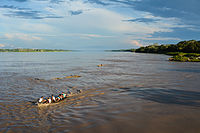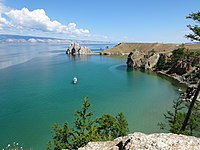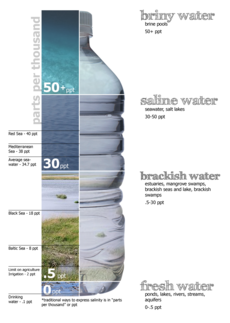Fresh water



Fresh water or freshwater is any naturally occurring liquid/solid water containing low concentrations of dissolved salts and other total dissolved solids. Although the term specifically excludes seawater and brackish water, it does include non-salty mineral-rich waters such as chalybeate springs. Fresh water may encompass frozen and meltwater in ice sheets, ice caps, glaciers, snowfields and icebergs, natural precipitations such as rainfall, snowfall, hail/sleet and graupel, and surface runoffs that form inland bodies of water such as wetlands, ponds, lakes, rivers, streams, as well as groundwater contained in aquifers, subterranean rivers and lakes.
Water is critical to the survival of all living organisms. Many organisms can thrive on salt water, but the great majority of higher plants and most insects, amphibians, reptiles, mammals and birds need fresh water to survive.
Fresh water is not always potable water, that is, water safe to drink by humans. Much of the earth's fresh water (on the surface and groundwater) is to a substantial degree unsuitable for human consumption without some treatment. Fresh water can easily become polluted by human activities or due to naturally occurring processes, such as erosion.
Fresh water is a renewable and variable, but finite natural resource. Fresh water can only be replenished through the process of the water cycle, in which water from seas, lakes, forests, land, rivers and reservoirs evaporates, forms clouds, and returns inland as precipitation. Locally, however, if more fresh water is consumed through human activities than is naturally restored, this may result in reduced fresh water availability (or water scarcity) from surface and underground sources and can cause serious damage to surrounding and associated environments. Water pollution and subsequent eutrophication also reduces the availability of fresh water.[1]
Definitions[]
| Part of a series on |
| Water salinity |
|---|
 |
| Salinity levels |
|
Fresh water (< 0.05%) Brackish water (0.05–3%) Saline water (3–5%) Brine (> 5% up to 26%-28% max) |
| Bodies of water |
Numerical definition[]
Fresh water can be defined as water with less than 500 parts per million (ppm) of dissolved salts.[2]
Other sources give higher upper salinity limits for fresh water, e.g. 1000 ppm[3] or 3000 ppm.[4]
Systems[]


Fresh water habitats are classified as either lentic systems, which are the stillwaters including ponds, lakes, swamps and mires; lotic which are running-water systems; or groundwaters which flow in rocks and aquifers. There is, in addition, a zone which bridges between groundwater and lotic systems, which is the hyporheic zone, which underlies many larger rivers and can contain substantially more water than is seen in the open channel. It may also be in direct contact with the underlying underground water.
Sources[]
The original source of almost all fresh water is precipitation from the atmosphere, in the form of mist, rain and snow. Fresh water falling as mist, rain or snow contains materials dissolved from the atmosphere and material from the sea and land over which the rain bearing clouds have traveled. The precipitation leads eventually to the formation of water bodies that humans can use as sources of freshwater: ponds, lakes, rainfall, rivers, streams, and groundwater contained in underground aquifers.
In coastal areas fresh water may contain significant concentrations of salts derived from the sea if windy conditions have lifted drops of seawater into the rain-bearing clouds. This can give rise to elevated concentrations of sodium, chloride, magnesium and sulfate as well as many other compounds in smaller concentrations.
In desert areas, or areas with impoverished or dusty soils, rain-bearing winds can pick up sand and dust and this can be deposited elsewhere in precipitation and causing the freshwater flow to be measurably contaminated both by insoluble solids but also by the soluble components of those soils. Significant quantities of iron may be transported in this way including the well-documented transfer of iron-rich rainfall falling in Brazil derived from sand-storms in the Sahara in north Africa.[citation needed]
Water distribution[]
Saline water in oceans, seas and saline groundwater make up about 97% of all the water on Earth. Only 2.5–2.75% is fresh water, including 1.75–2% frozen in glaciers, ice and snow, 0.5–0.75% as fresh groundwater and soil moisture, and less than 0.01% of it as surface water in lakes, swamps and rivers.[6][7] Freshwater lakes contain about 87% of this fresh surface water, including 29% in the African Great Lakes, 22% in Lake Baikal in Russia, 21% in the North American Great Lakes, and 14% in other lakes. Swamps have most of the balance with only a small amount in rivers, most notably the Amazon River. The atmosphere contains 0.04% water.[8] In areas with no fresh water on the ground surface, fresh water derived from precipitation may, because of its lower density, overlie saline ground water in lenses or layers. Most of the world's fresh water is frozen in ice sheets. Many areas have very little fresh water, such as deserts.
Freshwater ecosystems[]

Freshwater ecosystems are a subset of Earth's aquatic ecosystems. They include lakes, ponds, rivers, streams, springs, bogs, and wetlands.[9] They can be contrasted with marine ecosystems, which have a larger salt content. Freshwater habitats can be classified by different factors, including temperature, light penetration, nutrients, and vegetation. There are three basic types of freshwater ecosystems: Lentic (slow moving water, including pools, ponds, and lakes), lotic (faster moving water, for example streams and rivers) and wetlands (areas where the soil is saturated or inundated for at least part of the time).[10][9] Freshwater ecosystems contain 41% of the world's known fish species.[11]
Freshwater ecosystems have undergone substantial transformations over time, which has impacted various characteristics of the ecosystems.[12] Original attempts to understand and monitor freshwater ecosystems were spurred on by threats to human health (for example cholera outbreaks due to sewage contamination).[13] Early monitoring focused on chemical indicators, then bacteria, and finally algae, fungi and protozoa. A new type of monitoring involves quantifying differing groups of organisms (macroinvertebrates, macrophytes and fish) and measuring the stream conditions associated with them.[14] Threats to freshwater biodiversity include overexploitation, water pollution, flow modification, destruction or degradation of habitat, and invasion by exotic species.[15]Threats and challenges[]
The increase in the world population and the increase in per capita water use puts increasing strains on the finite resources availability of clean fresh water. The response by freshwater ecosystems to a changing climate can be described in terms of three interrelated components: water quality, water quantity or volume, and water timing. A change in one often leads to shifts in the others as well.[16]
Limited resource[]
Water scarcity (closely related with water stress or water crisis) is the lack of fresh water resources to meet the standard water demand. Two types of water scarcity have been defined: physical or economic water scarcity. Physical water scarcity is where there is not enough water to meet all demands, including that needed for ecosystems to function effectively. Arid areas (for example Central and West Asia, and North Africa) often suffer from physical water scarcity.[17] On the other hand, economic water scarcity is caused by a lack of investment in infrastructure or technology to draw water from rivers, aquifers, or other water sources, or insufficient human capacity to satisfy the demand for water. Much of Sub-Saharan Africa is characterized by economic water scarcity.[18]:11
The essence of global water scarcity is the geographic and temporal mismatch between fresh water demand and availability.[19][20] At the global level and on an annual basis, enough freshwater is available to meet such demand, but spatial and temporal variations of water demand and availability are large, leading to physical water scarcity in several parts of the world during specific times of the year.[21] The main driving forces for the rising global demand for water are the increasing world population, improving living standards, changing consumption patterns (for example a dietary shift toward more animal products),[22] and expansion of irrigated agriculture.[23][24] Climate change, such as altered weather-patterns (including droughts[25] or floods), deforestation, increased water pollution and wasteful use of water can also cause insufficient water supply.[26] Scarcity varies over time as a result of natural hydrological variability, but varies even more so as a function of prevailing economic policy, planning and management approaches. Scarcity can be expected to intensify with most forms of economic development, but, if correctly identified, many of its causes can be predicted, avoided or mitigated.[27]Minimum streamflow[]
An important concern for hydrological ecosystems is securing minimum streamflow, especially preserving and restoring instream water allocations.[28] Fresh water is an important natural resource necessary for the survival of all ecosystems. The use of water by humans for activities such as irrigation and industrial applications can have adverse impacts on down-stream ecosystems.
Fresh water withdrawal is the quantity of water removed from available sources for use in any purpose, excluding evaporation losses. Water drawn off is not necessarily entirely consumed and some portion may be returned for further use downstream.
Water pollution[]
Water pollution (or aquatic pollution) is the contamination of water bodies, usually as a result of human activities, in such a manner that negatively affects its legitimate uses.[29]:6 Water pollution reduces the ability of the body of water to provide the ecosystem services that it would otherwise provide. Water bodies include for example lakes, rivers, oceans, aquifers, reservoirs and groundwater. Water pollution results when contaminants are introduced into these water bodies. For example, releasing inadequately treated wastewater into natural waters can lead to degradation of these aquatic ecosystems. All plants and organisms living in or being exposed to polluted water bodies can be impacted. The effects can damage individual species and impact the natural biological communities they are part of. Water pollution can also lead to water-borne diseases for people using polluted water for drinking, bathing, washing or irrigation.
Global goals for conservation[]
The Sustainable Development Goals are a collection of 17 interlinked global goals designed to be a "blueprint to achieve a better and more sustainable future for all".[31] Targets on freshwater conservation are included in SDG 6 (Clean water and sanitation) and SDG 15 (Life on land). For example, Target 6.4 is formulated as "By 2030, substantially increase water-use efficiency across all sectors and ensure sustainable withdrawals and supply of freshwater to address water scarcity and substantially reduce the number of people suffering from water scarcity."[31] Another target, Target 15.1, is: "By 2020, ensure the conservation, restoration and sustainable use of terrestrial and inland freshwater ecosystems and their services, in particular forests, wetlands, mountains and drylands, in line with obligations under international agreements."[31]
Human uses[]
Uses of water include agricultural, industrial, household, recreational and environmental activities.
Water used for agriculture is called "agricultural water" or farm water.[32]
Animals[]
Water is a critical issue for the survival of all living organisms. Some can use salt water but many organisms including the great majority of higher plants and most mammals must have access to fresh water to live. Some terrestrial mammals, especially desert rodents, appear to survive without drinking, but they do generate water through the metabolism of cereal seeds, and they also have mechanisms to conserve water to the maximum degree.
See also[]
- African Great Lakes – Series of lakes in the Rift Valley
- Aral Sea – Lake between Kazakhstan and Uzbekistan
- Desalination – Removal of salts and minerals from a substance
- Drought – Extended period of deficiency in a region's water supply
- Limnology – Science of inland aquatic ecosystems
- List of countries by freshwater withdrawal
- List of countries by total renewable water resources – list of countries by total renewable water resources mostly based on The World Factbook
- Properties of water – Physical and chemical properties of pure water
References[]
- ^ "Nutrients in fresh water"
- ^ "Groundwater Glossary". 27 March 2006. Archived from the original on 28 April 2006. Retrieved 14 May 2006.
- ^ "Freshwater". Glossary of Meteorology. American Meteorological Society. June 2000. Archived from the original on 6 June 2011. Retrieved 27 November 2009.
- ^ "Freshwater". Fishkeeping glossary. Practical Fishkeeping. Archived from the original on 11 May 2006. Retrieved 27 November 2009.
- ^ USGS – Earth's water distribution Archived 29 June 2012 at the Wayback Machine. Ga.water.usgs.gov (11 December 2012). Retrieved on 29 December 2012.
- ^ Where is Earth's water? Archived 14 December 2013 at the Wayback Machine, United States Geological Survey.
- ^ Physicalgeography.net Archived 26 January 2016 at the Wayback Machine. Physicalgeography.net. Retrieved on 29 December 2012.
- ^ Gleick, Peter; et al. (1996). Stephen H. Schneider (ed.). Encyclopedia of Climate and Weather. Oxford University Press.
- ^ Jump up to: a b G., Wetzel, Robert (2001). Limnology : lake and river ecosystems (3rd ed.). San Diego: Academic Press. ISBN 978-0127447605. OCLC 46393244.
- ^ Vaccari, David A. (8 November 2005). Environmental Biology for Engineers and Scientists. Wiley-Interscience. ISBN 0-471-74178-7.
- ^ Daily, Gretchen C. (1 February 1997). Nature's Services. Island Press. ISBN 1-55963-476-6.
- ^ Carpenter, Stephen R.; Stanley, Emily H.; Vander Zanden, M. Jake (2011). "State of the World's Freshwater Ecosystems: Physical, Chemical, and Biological Changes". Annual Review of Environment and Resources. 36 (1): 75–99. doi:10.1146/annurev-environ-021810-094524. ISSN 1543-5938.
- ^ Rudolfs, Willem; Falk, Lloyd L.; Ragotzkie, R. A. (1950). "Literature Review on the Occurrence and Survival of Enteric, Pathogenic, and Relative Organisms in Soil, Water, Sewage, and Sludges, and on Vegetation: I. Bacterial and Virus Diseases". Sewage and Industrial Wastes. 22 (10): 1261–1281. JSTOR 25031419.
- ^ Friberg, Nikolai; Bonada, Núria; Bradley, David C.; Dunbar, Michael J.; Edwards, Francois K.; Grey, Jonathan; Hayes, Richard B.; Hildrew, Alan G.; Lamouroux, Nicolas (2011), "Biomonitoring of Human Impacts in Freshwater Ecosystems", Advances in Ecological Research, Elsevier, pp. 1–68, doi:10.1016/b978-0-12-374794-5.00001-8, ISBN 9780123747945
- ^ Dudgeon, David; Arthington, Angela H.; Gessner, Mark O.; Kawabata, Zen-Ichiro; Knowler, Duncan J.; Lévêque, Christian; Naiman, Robert J.; Prieur-Richard, Anne-Hélène; Soto, Doris (12 December 2005). "Freshwater biodiversity: importance, threats, status and conservation challenges". Biological Reviews. 81 (2): 163–82. CiteSeerX 10.1.1.568.4047. doi:10.1017/s1464793105006950. ISSN 1464-7931. PMID 16336747. S2CID 15921269.
- ^ The World Bank, 2009 "Water and Climate Change: Understanding the Risks and Making Climate-Smart Investment Decisions". pp. 19–22. Archived from the original on 7 April 2012. Retrieved 24 October 2011.
- ^ Rijsberman, Frank R. (2006). "Water scarcity: Fact or fiction?". Agricultural Water Management. 80 (1–3): 5–22. doi:10.1016/j.agwat.2005.07.001.
- ^ IWMI (2007) Water for Food, Water for Life: A Comprehensive Assessment of Water Management in Agriculture. London: Earthscan, and Colombo: International Water Management Institute.
- ^ S. L. Postel, G. C. Daily, P. R. Ehrlich, Human appropriation of renewable fresh water. Science 271, 785–788 (1996).
- ^ H. H. G. Savenije, Water scarcity indicators; the deception of the numbers. Physics and Chemistry of the Earth B 25, 199–204 (2000).
- ^ Mekonnen, Mesfin M.; Hoekstra, Arjen Y. (2016). "Four billion people facing severe water scarcity". Science Advances. 2 (2): e1500323. Bibcode:2016SciA....2E0323M. doi:10.1126/sciadv.1500323. ISSN 2375-2548. PMC 4758739. PMID 26933676.
- ^ Liu, Junguo; Yang, Hong; Gosling, Simon N.; Kummu, Matti; Flörke, Martina; Pfister, Stephan; Hanasaki, Naota; Wada, Yoshihide; Zhang, Xinxin; Zheng, Chunmiao; Alcamo, Joseph (2017). "Water scarcity assessments in the past, present, and future: REVIEW ON WATER SCARCITY ASSESSMENT". Earth's Future. 5 (6): 545–559. doi:10.1002/2016EF000518. PMC 6204262. PMID 30377623.
- ^ Vorosmarty, C. J. (14 July 2000). "Global Water Resources: Vulnerability from Climate Change and Population Growth". Science. 289 (5477): 284–288. Bibcode:2000Sci...289..284V. doi:10.1126/science.289.5477.284. PMID 10894773.
- ^ Ercin, A. Ertug; Hoekstra, Arjen Y. (2014). "Water footprint scenarios for 2050: A global analysis". Environment International. 64: 71–82. doi:10.1016/j.envint.2013.11.019. PMID 24374780.
- ^ Heidari, Hadi; Arabi, Mazdak; Ghanbari, Mahshid; Warziniack, Travis (27 May 2020). "A Probabilistic Approach for Characterization of Sub-Annual Socioeconomic Drought Intensity-Duration-Frequency (IDF) Relationships in a Changing Environment". Water. 12 (6): 1522. doi:10.3390/w12061522. ISSN 2073-4441.
- ^ "Water Scarcity. Threats". WWF. 2013. Archived from the original on 21 October 2013. Retrieved 20 October 2013.
- ^ "Coping with water scarcity. An action framework for agriculture and food stress" (PDF). Food and Agriculture Organization of the United Nations. 2012. Archived (PDF) from the original on 4 March 2018. Retrieved 31 December 2017. Text was copied from this source, which is available under a Creative Commons Attribution 3.0 IGO (CC BY 3.0 IGO) license.
- ^ Peter Gleick; Heather Cooley; David Katz (2006). The world's water, 2006–2007: the biennial report on freshwater resources. Island Press. pp. 29–31. ISBN 978-1-59726-106-7. Retrieved 12 September 2009.
- ^ Von Sperling, M. (2015). "Wastewater Characteristics, Treatment and Disposal". Water Intelligence Online. 6: 9781780402086. doi:10.2166/9781780402086. ISSN 1476-1777.
- ^ Moss, Brian (2008). "Water Pollution by Agriculture". Phil. Trans. R. Soc. Lond. B. 363 (1491): 659–666. doi:10.1098/rstb.2007.2176. PMC 2610176. PMID 17666391.
- ^ Jump up to: a b c United Nations (2017) Resolution adopted by the General Assembly on 6 July 2017, Work of the Statistical Commission pertaining to the 2030 Agenda for Sustainable Development (A/RES/71/313)
- ^ "USDA Economic Research Service - Irrigation & Water Use". www.ers.usda.gov. Archived from the original on 15 November 2015. Retrieved 17 November 2015.
External links[]
| Wikimedia Commons has media related to Freshwater. |
- Fresh water
- Aquatic ecology
- Hydrology
- Water supply